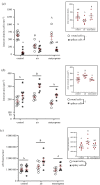Novel spikey ionocytes are regulated by cortisol in the skin of an amphibious fish
- PMID: 34933603
- PMCID: PMC8692953
- DOI: 10.1098/rspb.2021.2324
Novel spikey ionocytes are regulated by cortisol in the skin of an amphibious fish
Abstract
Cortisol is a major osmoregulatory hormone in fishes. Cortisol acts upon the gills, the primary site of ionoregulation, through modifications to specialized ion-transporting cells called ionocytes. We tested the hypothesis that cortisol also acts as a major regulator of skin ionocyte remodelling in the amphibious mangrove rivulus (Kryptolebias marmoratus) when gill function ceases during the water-to-land transition. When out of water, K. marmoratus demonstrated a robust cortisol response, which was linked with the remodelling of skin ionocytes to increase cell cross-sectional area and Na+-K+-ATPase (NKA) content, but not when cortisol synthesis was chemically inhibited by metyrapone. Additionally, we discovered a novel morphology of skin-specific ionocyte that are spikey with multiple cell processes. Spikey ionocytes increased in density, cell cross-sectional area and NKA content during air exposure, but not in metyrapone-treated fish. Our findings demonstrate that skin ionocyte remodelling during the water-to-land transition in amphibious fish is regulated by cortisol, the same hormone that regulates gill ionocyte remodelling in salinity-challenged teleosts, suggesting conserved hormonal function across diverse environmental disturbances and organs in fishes.
Keywords: Kryptolebias marmoratus; fish; gill; ionoregulation; ions; metyrapone.
Figures



References
-
- McCormick SD. 1995. Hormonal control of gill Na+,K+-ATPase and chloride cell function. Fish physiol. 14, 285-315.
-
- Stiffler DF, Graham JB, Dickson KA, Stöckmann W. 1986. Cutaneous ion transport in the freshwater teleost Synbranchus marmoratus. Physiol. Zool. 59, 406-418. (10.1086/physzool.59.4.30158594) - DOI
Publication types
MeSH terms
Substances
Associated data
LinkOut - more resources
Full Text Sources

